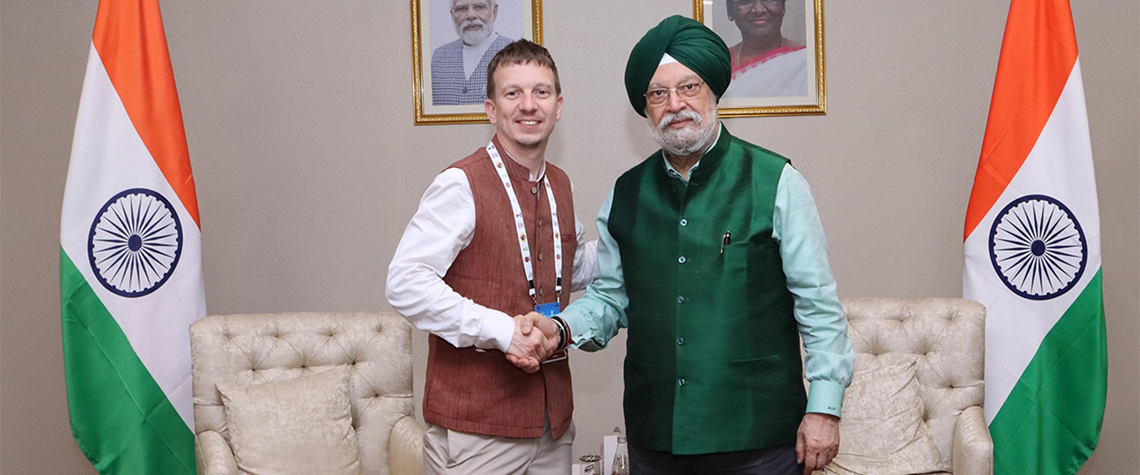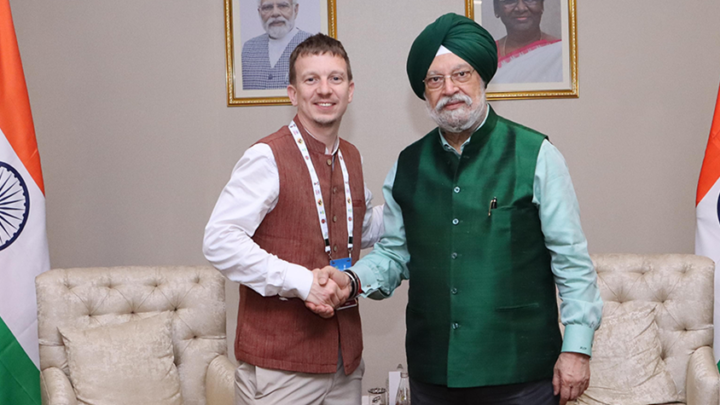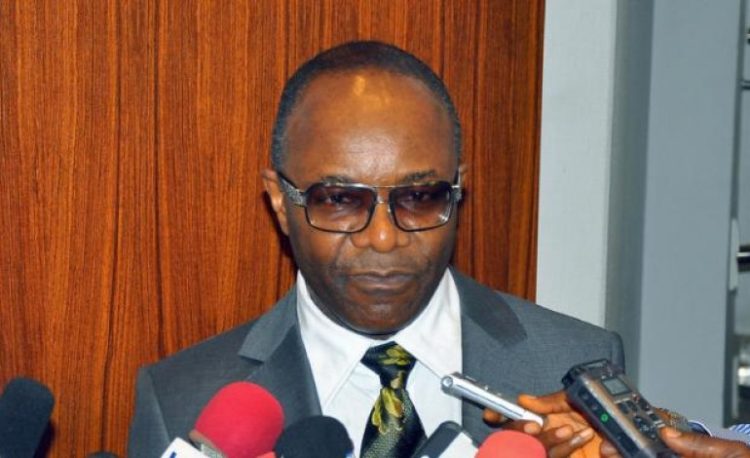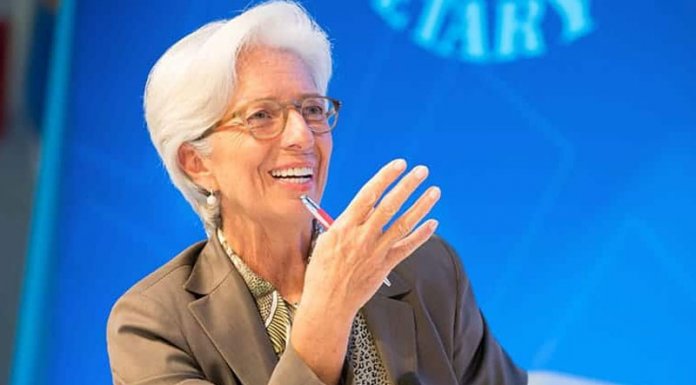By Paul Hickin
Hardeep Singh Puri says upstream oil is vital as country goes all out to boost its energy sector across E&P, gas, biofuels and hydrogen amid booming demand
“Our upstream strategy is not just a push. It is a strong imperative,” Indian energy minister Hardeep Singh Puri told Petroleum Economist in an exclusive interview, explaining how exploration and production is a vital cog in India’s energy wheel. Puri pointed out there is a danger when oil prices are relatively stable that countries can be lulled into complacency.

Petroleum Economist’s Editor-in-Chief, Paul Hickin, with Hardeep Singh Puri, India’s minister for petroleum and natural gas
India Politics
“If you can access energy at a cheap price, why should one make major investments to do E&P? India has learned the hard way,” the minister of petroleum and natural gas said in a one-to-one discussion on the sidelines of India Energy Week in February. Puri said that, while many economies have fallen into the complacency trap, India has been determined to put in place a clear plan of action so as to cut its dependence on oil by tapping into the country’s potential.
“After [Prime Minister Narendra] Modi came in, and particularly in the last few years after he assumed power, we discovered that the global environment will continue to be characterised by some sense of uncertainty. We also realised that, while our economy was growing and we needed to import—and we are importing large amounts of energy—we also needed to not be dependent on that as a crutch—so we needed to expand our E&P”, an impassioned Puri said.
“The West is in an intellectual dilemma of its own making” Puri, Indian energy minister
And India’s government delivered. It released no-go areas in India’s exclusive economic zone for E&P operations covering a total of 1m km² off the west coast, the east coast and the Andaman and Nicobar islands to provide a boost to exploration. “This opening up for E&P was done not too long back, and it is already showing results. People are discovering oil”, Puri noted. State-owned Oil and Natural Gas Corporation (ONGC) has made two significant back-to-back discoveries in a Mahandi Basin deepwater block off the Bay of Bengal, an area traditionally barred to E&P.
Puri also said there has been a change in attitude to international investment. “It is one thing to tell a foreign company to come and explore in India, but once they find oil then say this is sovereign land—they will just get disenchanted, so we changed our attitude.” India has made great strides in providing data and incentivising exploration.
“We will go into revenue-sharing and have a contract so there is no ambiguity”, Puri added, highlighting the country had lost several major energy companies but that “now they are back”. He said one such firm, ExxonMobil, is devoting 20% of its supercomputing time as an example of the seriousness of the international return. Puri underlined the positivity with a big discovery at home. ONGC, India’s largest crude oil producer, will start commercial production from its much-awaited and much-delayed KG-DWN-98/2 project in the Krishna-Godavari (KG) Basin in the next couple of months. “The pressure is very good. We’re hoping for 40,000–50,000 barrels a day by May or June. E&P is getting a big boost,” Puri said.
Consumption boom
Puri was also upbeat on India’s gas strategy, highlighting the fact that production has been increasing by 18% year-on-year over the past three years. But the minister also provided a sobering dose of realism for the path ahead. “The truth is, we still need to import about 45–50% of our gas needs”, he pointed out. India has a strong economy—with GDP growth consistently well over 7% and even jumping above 8% in the October–December period—and is now the world’s most populous nation.
“All the other indicators are that the economy will keep doing well, and the consumption of energy is always a pretty good indicator of how the economy is doing”, Puri said. He added that “we consume 5m b/d of crude, and the rate at which our consumption is going up, people would see that maybe rising to 6–7m b/d, and now they are talking about 10–11m b/d because there is a momentum to use more energy” Puri said.
The minister said India is well placed to meet these growing energy needs, given its accelerated timeline around the green and clean energy sector, and its rethinking of targets so they do not become self-imposed limits. India is the world’s third-largest consumer of oil, the third-largest buyer of LPG, the fourth-largest importer of LNG and the fourth-largest market for automobiles. Puri said India’s growth story is centred around huge capex outlays, and that the country’s economic success story will go hand-in-hand with its energy expansion.
Biofuels bonanza
India is also making a transition, and its biofuels industry is flourishing. The country even met its 10% target on biofuel blending, set for November 2022, five months ahead of schedule. In 2014, India blended less than 1.5% of ethanol with gasoline, but this figure is now 12%, Puri said, adding the country has a 20% target for 2030 that is being brought forward to 2025. He added that the government is also reviewing this 20% target goal so it is not a limiting factor.
“I believe in the scope for collaboration between India, Indian companies and foreign economic entities, and that is why India Energy Week has so many people turning up,” Puri said, stressing India’s increased open-door policy and Modi’s mantra that “India is with the world and India is for the world”.
“I believe in the scope for collaboration between India, Indian companies and foreign economic entities” Puri, Indian energy minister
“There are cutting-edge technologies. We want to collaborate in that. We also want to involve the Global South. But countries in the Global South do not have an identical set of issues. Some of them are facing critical energy deficiencies, [for example, not having enough] clean cooking fuel,” Puri explained. “But India is demonstrating that you can make the transition with your own resources” and Puri believes India’s model of using all indigenous plants is an experience that can be replicated on a large scale in the Global South. Puri highlighted the importance of the Global Biofuels Alliance (GBA), especially given the push around sustainable aviation fuel (SAF) and the boom in the aviation transition.
To promote biofuels in India, the National Biofuels Coordination Committee agreed in November 2023 to a 1% SAF indicative blending target in 2027 and a 2% target in 2028 (initially for international flights in both cases).
In addition, in a major step towards enhancing use and adoption of compressed biogas, the government has announced the introduction of phase-wise mandatory blending of compressed biogas (CBG) in the CNG (transport) & pipeline gas (domestic) segments of the city-gas distribution sector. The CBG Blending Obligation (CBO) will be kept as 1%, 3% and 4% of total CNG/PNG consumption for 2025–26, 2026–27 and 2027–28 financial years respectively. From FY 2028–29 onwards, the CBO will be 5%.
India has just inaugurated Indian multinational Praj’s SAF demo facility in Pune and is open to collaboration on biofuels with the international community. Puri said that, with the launch of the GBA last September, the global biofuels market is set to quickly more than double in value to $200b. The increased use of biofuels has helped reduce the country’s import bill as well as make fuel consumption greener.
Clear gas vision
The minister spelled out a clear and pragmatic energy strategy unlike those of some of its policymaking peers in Europe and the US. “The West is in an intellectual dilemma of its own making,” Puri said, emphatically declaring that “natural gas is totally clean”.
India’s coal consumption is vast, and with many analysts expecting it to grow further there is ample room for coal-to-gas switching to enable a sustainable transition. “I always say that you have to define where you are and where you are going. Compared with all the others, ultimately you want an energy that produces only water vapour. [With] natural gas, you can progress,” Puri said. “But we are at the stage where we have taken a conscious policy decision to move from 6% to 15% of gas in the energy mix by 2030. And that requires $67b of investment in the next 5–6 years. A lot of it is happening,” he added.
Puri pointed to the landmark long-term agreement with QatarEnergy as the shape of things to come. “We also have a situation in which we are importing about $20b of energy from the US, some natural gas, economic entities which want to sell US gas. Gas is going to be more readily available. And that is good news because our consumers need it,” the minister explained.
“Our transition strategy is very clear,” he added, noting that gas is a key transition fuel. “It has to be because, otherwise, what would we use? We would use firewood, charcoal, kerosene and coal. Not a good idea. India is in transition. And the energy transition is one of those transitions taking place. There are multiple transitions.”
Puri has set out a multi-pronged strategy to diversify India’s energy mix, slash total emissions by 1bt by 2030 and reach 50% of power generation through renewables by the end of the decade. Moving to a gas-based economy supported by biofuels and green hydrogen is central to that vision.
Oil buying strategy
Indian refiners have been opportunistic crude buyers, switching to Russian barrels in 2022 and 2023 to take advantage of lucrative margins and profits. Russian crude has generally been at a discount to Brent, but when that gap has narrowed, India has looked to diversify its crude slate, taking more volumes from the Middle East and Africa. Puri explained the thinking behind the behaviour, noting “the Indian buying strategy is very simple”.
“The truth is, we still need to import about 45–50% of our gas needs” Puri, Indian energy minister
Puri, speaking only for the public sector companies—India’s oil marketing firms—said price is the ultimate factor. “If they need oil, they will float a tender. They have their own refineries. Many of them have other related activities. Whoever bids the lowest price, they will have won the tender. And it is an open tender. There is no secret tendering,” the energy minister said. Puri also said, with regard to signing long-term agreements, that it is, again, very simple. “If the long-term agreement is really attractive, then that is the deal, as otherwise you can buy cheaper on the spot market.”
Puri highlighted how India pivoted from buying practically no Russian barrels before Russia’s invasion of Ukraine to 2m b/d based on price. India had traditionally been buying around a fifth of its 5m b/d of crude from Saudi Arabia, the UAE, Iraq, Kuwait and some smaller suppliers, and then suddenly some of these providers started to price crude much more cheaply. “We have had this alternating situation,” Puri said. “It is a very simple price function,” he added, explaining that the media or analysts often get carried away when Russia’s volumes ebb and flow.
“Now, if there is a global turbulence somewhere down the supply routes, it stands to reason that the more proximate point that is not affected by the supply route will have an advantage. So, it is a simple explanation,” Puri added, proving insight into disruptions in the Red Sea and how they could influence India’s buying process.
India’s SPR
India’s plans around strategic petroleum reserves (SPRs) have lagged many other big oil importers. However, three facilities at Visakhapatnam, Mangalore and Padur were commissioned in June 2015, October 2016 and December 2018 respectively. With a total designed capacity of 5.33mt (equivalent to about 38 m bl), the three sites can provide for around 9.5 days of India’s crude oil requirements, based on 2019–20 consumption. Some analysts have questioned whether it is too little, too late for India to build out costly storage space, but others see India’s appetite for oil remaining in the longer term. India imports more than 87% of its oil needs.
Puri said that “A country such as India, which has a long-term stake in SPRs, will obviously take it seriously. However, the energy minister also said the government is a little more flexible when looking at what constitutes back-up supply. “We calculate our SPR not only in what is inside the cavern or wherever it is, wherever it is going, but what is inside the refineries,” Puri explained. “So, when somebody says, ‘well, you have got only eight days cover’, this is not correct. “Secondly, I might decide my refineries at any given time have so much oil, plus the oil in the pipeline, plus the oil in the storage in tankers off the coast, which have just come in and the oil from which will just go into the pipeline,” Puri added.
“Even that which we are holding, we allow 50% to be commercially traded because a lot of the oil is just lying there as a strategic reserve, and as a non-productive asset of 50% we are using, so it is well thought out.” India’s thinking around SPRs is, like its buying strategy, based around cost and price and having a broader view around flexibility.
Hydrogen hub
India has been on a mission to turn itself into a hub for hydrogen technology, including utilisation and export. “As part of that plan, we are aiming to produce 5mt/yr of green hydrogen by 2030,” Puri said, adding that this figure could double, depending on the pace of exports.
He noted India has domestic demand that will help meet the targets, especially with industries such as steel and fertiliser that could benefit from the use of green hydrogen. Oil and gas PSUs have plans to setup green hydrogen projects of c.1mt/yr by 2030. Puri sees green hydrogen as an important piece in the net-zero puzzle and in helping bring forward the 2070 net-zero deadline.
Infrastructure push
At India Energy Week, the message from the country’s leaders was clear: India’s exponential economic and energy demand growth will need to be supported by an all-energies approach, with gas playing a crucial role in supporting the boom in a sustainable fashion. India is investing in energy like never before and building out the necessary infrastructure—from refineries and pipelines to everything that enables renewables—with $11t in the budget allocated to achieving these goals.
Puri stated that at a “crucial juncture in the global economy, with multiple crises”, it was important to ensure availability, affordability and sustainability of energy, while prioritising the country’s energy security. “India is becoming a demand hub for global energy,” Puri added.
This powerhouse stands ready to lead the world in energy with a pragmatic and honest approach to energy and emissions and solving the dichotomy between economic growth and a sustainable fuel supply.
Source: Petroleum Economist






